
Zygoballus is a genus of jumping spiders found in North and South America.
Pimoidae is a small family of araneomorph spiders first described by J. Wunderlich in 1986. As re-circumscribed in 2021, it is monophyletic, and contained 85 species in two genera. It is closely related to the Linyphiidae, and is sometimes treated as synonymous with that family.
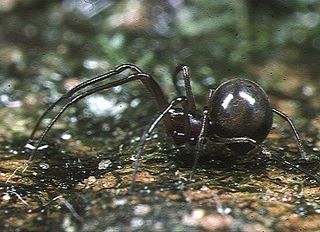
Anapidae is a family of rather small spiders with 231 described species in 58 genera. It includes the former family Micropholcommatidae as the subfamily Micropholcommatinae, and the former family Holarchaeidae. Most species are less than 2 millimetres (0.079 in) long.
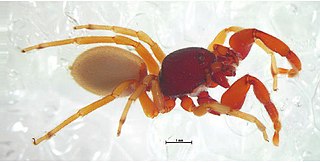
The Palpimanoidea or palpimanoids, also known as assassin spiders, are a group of araneomorph spiders, originally treated as a superfamily. As with many such groups, its circumscription has varied. As of September 2018, the following five families were included:

The Entelegynae or entelegynes are a subgroup of araneomorph spiders, the largest of the two main groups into which the araneomorphs were traditionally divided. Females have a genital plate (epigynum) and a "flow through" fertilization system; males have complex palpal bulbs. Molecular phylogenetic studies have supported the monophyly of Entelegynae.
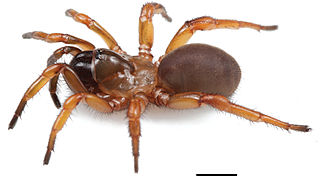
Myrmekiaphila is a genus of North American mygalomorph trapdoor spiders in the family Euctenizidae, and was first described by G. F. Atkinson in 1886. All described species are endemic to the southeastern United States.
Anelosimus nelsoni is a species of spider in the family Theridiidae. It is only known from iSimangaliso Wetland Park, KwaZulu-Natal, South Africa. It is named for Nelson Mandela. The male holotype specimen is 2.08 millimetres (0.082 in) in length, and the female paratype is 2.60 millimetres (0.102 in) in length. Both the holotype and paratype were found on Fanies Island, 5 km south of Cape Vidal. Both were collected from bushes or trees in an open forest patch.
Anelosimus agnar is a species of spider in the family Theridiidae. The holotype and paratype specimens were collected in Teluk Mahkota, Johor, Malaysia. Both specimens are female; this species currently lack information on males. The spider is named for Agnar Ingólfsson, the father of the discoverer, Ingi Agnarsson. Females can be identified as members of this species by unusually long and flimsy copulatory ducts. Females range in size from 2.05 to 2.40 millimetres. Both the holotype and paratype were collected from small webs at the tips of branches, from a forested area next to a beach.
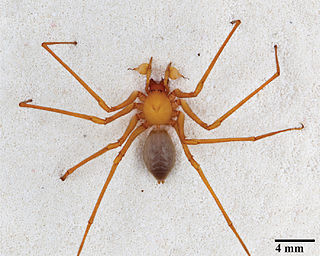
Trogloraptor is a genus of large spiders found in the caves of southwestern Oregon. It is the sole genus in the family Trogloraptoridae, and includes only one species, Trogloraptor marchingtoni. These spiders are predominantly yellow-brown in color with a maximum leg span of 3 in (7.6 cm). They are remarkable for having hook-like claws on the raptorial last segments of their legs.
Acanthogonatus confusus is a mygalomorph spider of Argentina and Chile, its name referring to the confusion between this species and A. subcalpeianus. Males are recognized by their long palpi, together with the absence of a tibial apophysis; females are recognized by the spermathecae.
Acanthogonatus huaquen is a mygalomorph spider of Chile, its name referring to its type locality: Huaquén, Chile. Males are recognized from other two-clawed Acanthogonatus by the bulb with a lateral keel delimiting a concave area; females by the spermathecae with an almost conical basal mound and its duct arising from its tip.
Chilelopsis calderoni is a species of mygalomorph spiders of Chile, named after Dr Raúl Calderón. Males differ from C. puertoviejo in the more sinuous distal portion of the bulbal duct; females differ in the spermathecae with a distinct fundus and a narrowed duct. Males differ from C. serena by the presence of a dense patch of setae on the anterior tibiae, females in the undivided spermathecae.

Paratropis tuxtlensis is a species of spiders in the family Paratropididae. Discovered in 2014 by a group of researchers from the National Autonomous University of Mexico, the species is only known to occur in the Volcán San Martin Biosphere Reserve in Veracruz, Mexico.
Pinkfloydia is a genus of small Australian long-jawed orb-weavers, reaching a maximum lengths of about 4.5 millimetres (0.18 in). It was first described by D. Dimitrov & G. Hormiga in 2011, and contains two species, found in New South Wales and Western Australia: P. harveyi and P. rixi. They have a unique rounded, cone-shaped head structure with one pair of large eyes and three pairs of smaller eyes. The genus is named after British rock band Pink Floyd.
Exechocentrus is a genus of Madagascan orb-weaver spiders first described by Eugène Simon in 1889. It is a bolas-using spider, capturing its prey with one or more sticky drops at the end of a single line of silk rather than in a web.
Sandinista lanceolatum is a species of spider in the family Theraphosidae (tarantulas), native to Nicaragua and Costa Rica.
Noideattella tsiba is a species of araneomorph spider in the family Oonopidae,. This species can only be found on the African island Madagascar. Two individual specimens were collected when the species was first discovered. The first was a male holotype which measured 1.4 mm across. The other, a female paratype measured 1.6 mm.
Caponina papamanga is a species of araneomorph spider from the Brazilian Amazonia. It is the first species of the genus Caponina from the region. It belongs to the family Caponiidae, which is described as ecribellate and haplogyne.
Exechocentrus lancearius is a species of spider in the orb-weaver spider family Araneidae, found only in Madagascar. It was initially described from a partial specimen of an adult female. The first description of a complete specimen and its prey-catching behaviour was published in 2012. E. lancearius is a bolas spider. Rather than using a web, adult females catch their prey by using a line with one or two sticky drops which they swing.
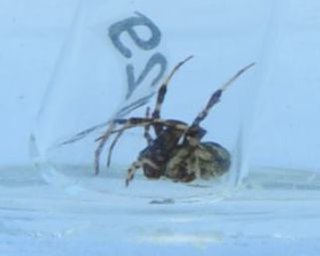
Gea eff is a species of orb-weaver spider. It is found in Papua New Guinea. The arachnologist Herbert Walter Levi formally described the species in 1983. While it was still undescribed, Michael H. Robinson and colleagues reported on its courtship and mating behaviors. Gea eff has the shortest scientific name of any spider species.







